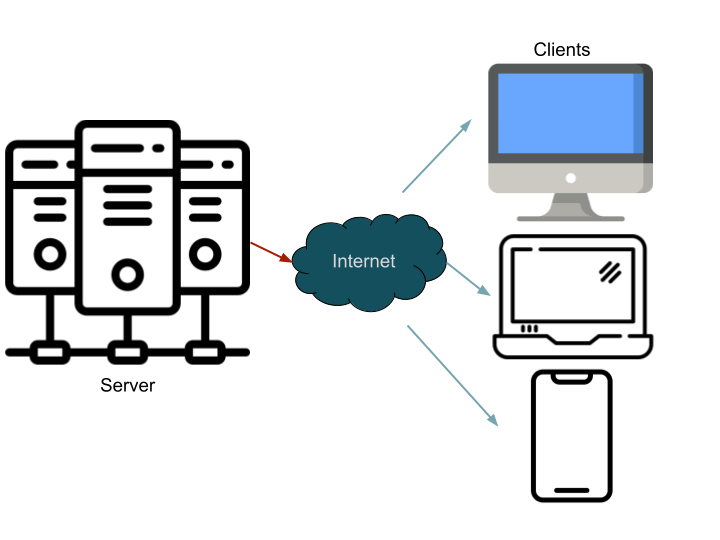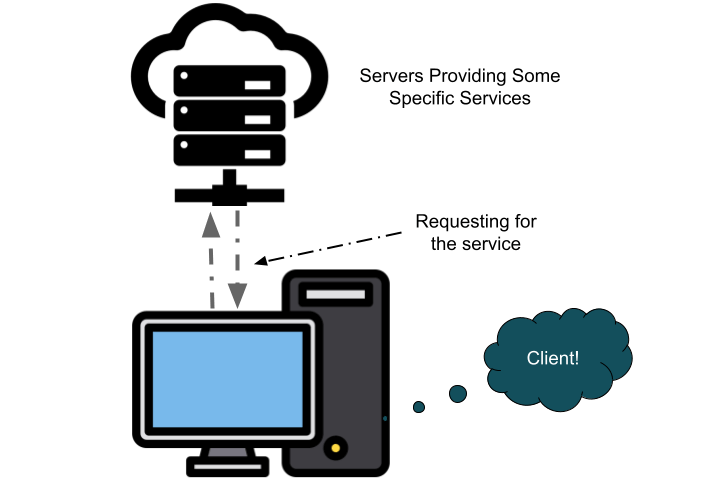What if I say, in this current world we’re all somehow a client in computer networks? Would you believe it? You’ve to as you’re currently reading our article through a browser, you are a client at this very moment. So, the burning question is, what is a client in a computer network and how does it work? Let’s find out the answers in detail.
What is a Client?
A client is any computer or workstation that connects to a distant computer or server within a computer network and uses some services or resources from them. Any service used or work done by the client is referred to as client-side. A client device can be a desktop, laptop, smartphone, or tablet. So, in short, a client requests some kind of service from a server.
What is a Server?
A server can be a program or a device that provides some kind of service to users who are known as clients on demand. These services provided by servers include sharing information or resources with numerous clients or maybe executing some computational tasks for the client.
Interaction Between Client and Server in Computer Network
In a computer network, clients and servers interact with each other through a request-response protocol. This request-response pattern is monitored through a communication protocol named TCP/IP(Transmission Control Protocol/Internet Protocol). Client and server can interact from a distant location or they might reside on the same machine and interact by interprocess communication.
At a single time, one or multiple clients can request the same services from a server. However, a single server computer can carry out a finite number of tasks limited by its capability. So, the server responds in a scheduling policy and responds to clients based on priority.
Client Side vs Server Side in Computer Network
Client-side refers to any tasks or operations happening on the end user’s bloc. On the other hand, a server-side refers to tasks or processes that are happening on the server.
For example, You’re currently on our browser, and the tasks that are occurring on your computer to manage the user interface and display graphical contents can be interpreted as a client-side program. Conversely, operations occurring on the server that conducts the spawning of the web content can be interpreted as server-side programs.
Types of Clients in Computer Network
We can classify clients in various parameters. Let’s look into a few of them.
1. Based on the Requirement of Resources
We can specify four different types of clients based on their resource and data processing requirements.
- Thick Client: Clients that rely mostly on themselves for resources and data processing rather than heavily depending on the server are known as Thick
- Thin Client: Thin client relies on the resources of the host server and carries out data optimizations on the server.
- Hybrid Client: As the name suggests, this type of client is a mixture of both Thick and Thin They perform the tasks of data optimization on their local hardware but rely on the server for storing data. The hybrid client is also known as the Diskless node.
- Zero Client: The concept of zero clients is similar to thin clients to some extent but more cost-effective than thin clients. As zero clients do not need to meet any configuration and storing requirements.
| Type | Server Storage Dependency | Server CPU Dependency | Costs |
|---|---|---|---|
| Thick Clients | NO | NO | $$$ |
| Hybrid Clients | YES | NO | $$ |
| Thin & Zero Clients | YES | YES | $ |
2. Based on Their Operating System
We have listed below a few types of clients based on the operating system:
- Windows clients, are basically computers running on Windows OS.
- Apple client, computer running on Mac OS.
- Linux client, computers running on Linux-based OS.
- Smartphones or Tablets that are running on Android or any mobile OS.
- Other IoT(Internet of Things) devices.
An Example of a Client-Server Model in Computer Network
In the client-server networking model, servers extend some sort of network-based functionalities to the user client on the basis of the request from the client.
Conclusion
In this modern day-to-day life, you’re relying on some sort of aid from network-based services. Unconsciously or consciously you’re a client of a service. Henceforth a basic idea of client-server relations and how a client in a computer network works is significant to enrich your perspective on sharing and growing.
People May Ask
What is host and client in networking?
In networking, a host refers to any device that is connected to a network and has its own unique identifier, such as an IP address. Hosts can be computers, servers, printers, or any other device that can send or receive data on a network. On the other hand, a client is a specific type of host that typically initiates requests for services or resources from other devices, known as servers, within the network. Clients can be software applications running on a computer, like web browsers or email clients, seeking data or services from servers.
What is the role of the client computer?
The client computer plays a crucial role in network communication by initiating requests for services or resources from other devices, commonly referred to as servers. Clients are active participants in the client-server model, where they seek specific information, applications, or services from servers within the network.
When a user interacts with a web browser, for instance, the browser acts as a client that sends requests for web pages to web servers. Similarly, in email communication, an email client initiates requests to mail servers to send or retrieve emails. Clients are responsible for making inquiries, processing responses, and presenting the results to the end user. They act as the consumers of networked services, relying on servers to fulfil their requests and provide the necessary data or functionality.
What is client’s status?
The client’s status in networking typically refers to the current state or condition of a client computer within a network. This status can encompass various aspects, including its connectivity, availability, and performance. Monitoring a client’s status is essential for network administrators to ensure the smooth functioning of the network. It involves checking whether the client is online, responsive, and properly connected to the network.
Additionally, the status may include information about the client’s resource utilization, such as CPU usage, memory usage, and network bandwidth consumption. Network management tools often provide insights into the real-time status of clients, enabling administrators to identify and address issues promptly, ensuring the overall health and efficiency of the network.
Similar Readings
- What is Host in Computer Network? [A Total Overview]
- What is Server in Computer Network [A Complete Guide]
- What is TCP/IP? [A Complete Overview]
FUNDAMENTALS A Complete Guide for Beginners






